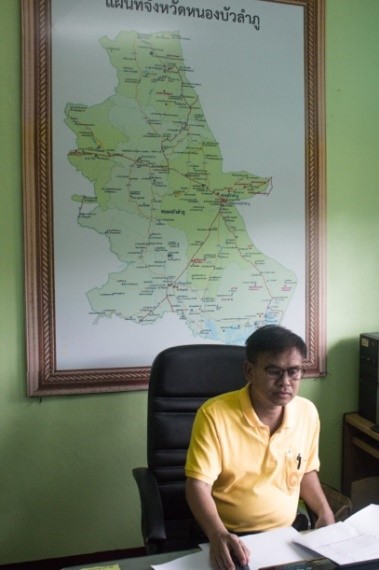By Donlawat Sunsuk
MUANG DISTRICT, NONG BUA LAMPHU – In the past five years, Nong Bua Lamphu province has witnessed a five-time increase in the area cultivated in sugarcane fields. A large number of farmers are switching from growing sticky rice, the area’s traditional main crop, to cultivating sugarcane which requires the use of more chemical pesticides. Public health and agriculture experts are concerned that the spike in toxic chemical discharge is making residents sick and adversely impacting the environment.

Towering sugarcane next to rice paddies in Hua Na sub district, Muang district in Nong Bua Lamphu province.
Kanja Chaduang, a 43-year-old sugarcane farmer in Pho Srisa-nga village in Nong Bua Lamphu’s Muang district has been growing rice on his 32 rai (about 12.6 acres) of farmland for decades. But in recent years, his yields have consistently declined as the area was hit hard by flash floods and severe droughts. To make things worse, the market price of rice has plummeted, leaving his family with little left over to live on.
Mr. Kanja decided to give up on rice farming and switch to sugarcane as the crop is known to be more resilient against floods and easier to cultivate. His initial investment was high, he said, but it paid off as he is now making 5,000 to 7,000 baht per rai per harvest.
In contrast, farmers in 56 provinces only made an average net income of 271 Baht per rai last year, according to information from the Ministry of Agriculture and Cooperatives.
Selling the crop also proved easier as middlemen buyers pick up the produce from the field, unlike rice yields that needed to be transported to the market at Mr Kanja’s own expense.
For his family consumption, Mr. Kanja keeps growing sticky rice only on two rai of land but he said he would not grow it for sale anymore as rice cultivation is too labor intensive and the market price continues to be dismally low.
This year, more than one third of the available agricultural land in Nong Bua Lamphu is used for sugarcane plantations and, according to the provincial Office of Agricultural Economics, the amount is expected to rise. In contrast, the area used for rice farming shrunk dramatically by 73 percent in the past six years.
Out of 1,200 rai of farming land in Ban Pho Srisa-nga village, about 500 rai are dedicated to sugarcane, land which Mr. Kanja says was rice paddies before 2010.
The local government and sugar mill investors encourage farmers in the area to abandon rice farming and switch to sugarcane. Nong Bua Lamphu has two sugarcane mills and there are at least seven more in nearby provinces.
Somsak Khanphai, Acting Head of the Strategy and Information Group of the Office of Agricultural Economics in Nong Bua Lamphu, says that it is part of the government’s agricultural strategy to reduce the number of rice paddies in areas where the soil is deemed unsuited for it. The office encourages farmers to grow crops that require little water in areas prone to droughts.

Caption 2 – Mr. Somsak Kanphai, Acting Head of Strategy and Information Group, the Provincial Agricultural Office of Nong Bua Lamphu, shares information about a 2014 policy on agricultural zoning, where the state is encouraging sugarcane growing.
Thailand ranks second in the world in sugarcane exports after Brazil. The country’s annual worth of export is over 1.9 billion baht (about USD 54.3 million), and the industry provides employment for over 600,000 people.
The sugarcane boom in the Northeast over the past five years has increased the area under sugarcane cultivation by 37 percent. The crop takes up 4.4 million rai in the region, or almost 44 percent of all agricultural lands used for sugarcane cultivation in the country, according to data from the Office of Agricultural Economics.
At the same time, the area used for rice farming dipped by nine percent between 2011 and 2015 as thousands of farmers shifted to more profitable crops.
Despite stabilizing farmers’ incomes in Nong Bua Lamphu province, like that of Mr. Kanja, the dramatic increase of sugarcane plantations has left public health experts concerned. Sugarcane farmers make intensive use of herbicides and spray their fields up to four times a year.
In Pho Srisa-nga village, 95 percent of all farming land is cultivated under the use of chemicals. Farmers also burn sugarcane plants before the harvest to simplify the cutting process, a practice that results in toxic smog.
Pattanaporn Khonpol, head of the Health Promoting Hospital in Hua Na sub district, says the use of pesticides will have a negative effect on farmers’ health both in the short and long run. Blood tests of 473 farmers in the area show that around 20 percent face health risks due to high levels of toxic chemicals in their bloodstreams.
In the past, the widespread use of pesticides in watermelon cultivation in the sub-district took such a toll on the health of farmers that watermelon farming had to be stopped. However, the use of agricultural pesticides in the area continued.
Last year, residents organized a public forum to draw attention to the issue at which farmers’ blood samples were taken on the spot for testing. Public health experts say that this helped to raise public awareness, especially among those farmers whose health proved at risk based on the blood test results.
The overall picture is improving as a joint community organization has begun to inform and educate local leaders, village health volunteers, and the youth in public schools about health and safety measures when working with pesticides and the potential health risks
Pradam Samana, village head of Pho Srisa-nga, said that the community has agreed on banning the use of pesticides and the burning of sugarcane fields within 500 meters of the village.
However, some farmers refuse to follow these rules because of the convenience in using chemicals to free their fields of weeds. Also, day laborers from outside the village tend apply pesticides in large amounts, according to Mr. Pradam.
As residents in Pho Srisa-nga village are coping with side effects of the boom in sugarcane, the cash crop’s expansion is likely to continue. In a ten-year policy plan, the government encourages the private sector to invest in sugar manufacturing, which is expected to further increase the number of sugarcane plantations in Nong Bua Lamphu province and the Isaan region at large.
Donlawat Sunsuk is a participant of The Isaan Journalism Network Project, organized by The Isaan Record.




